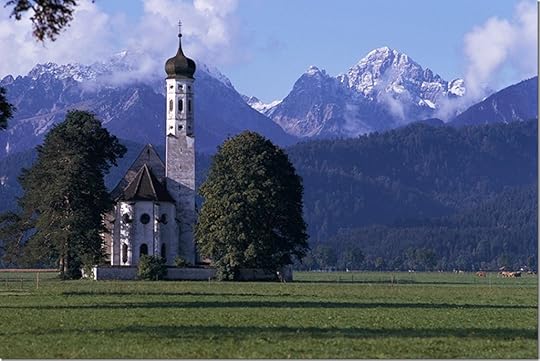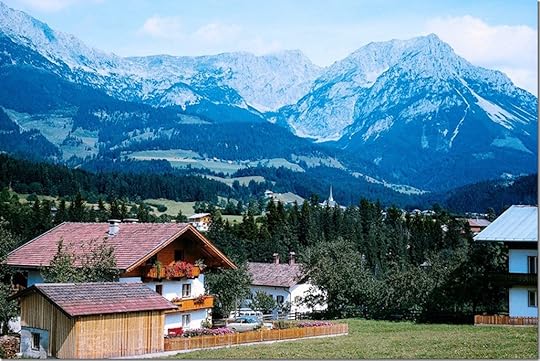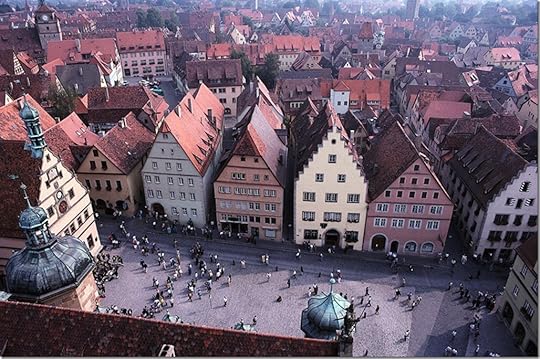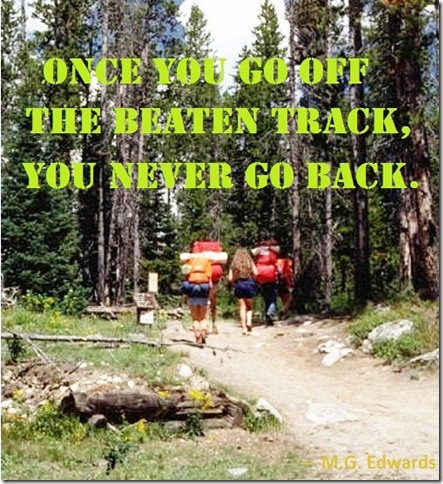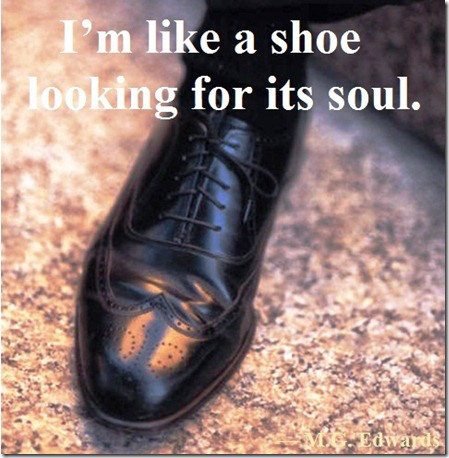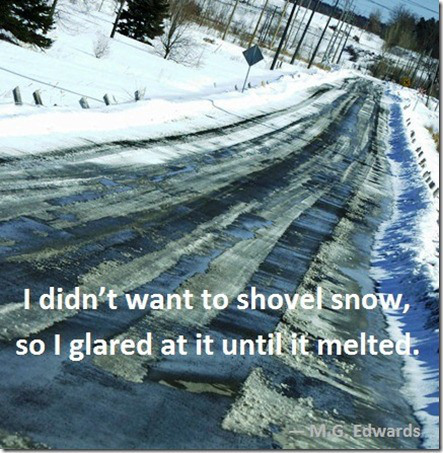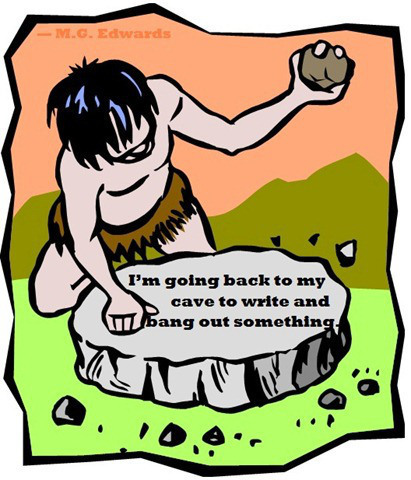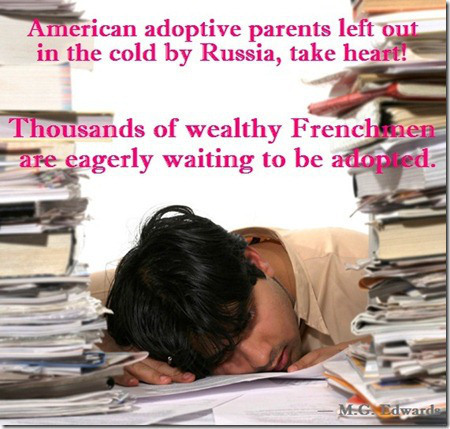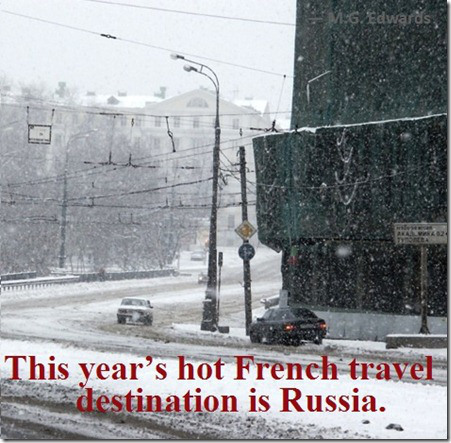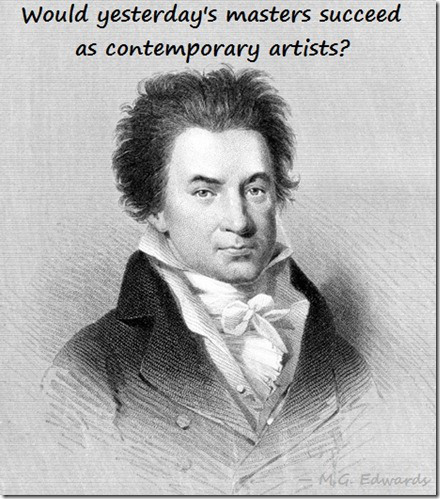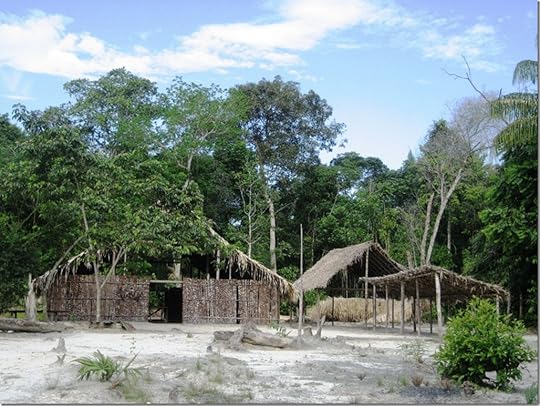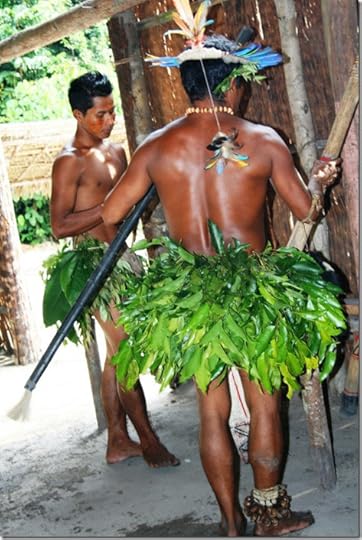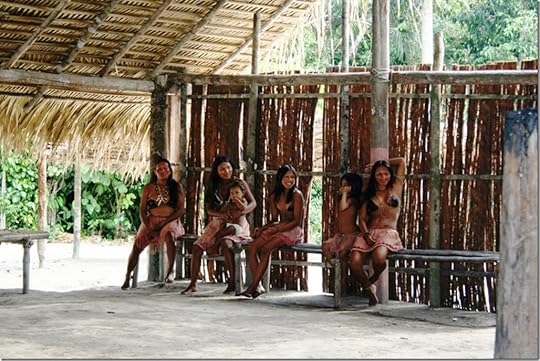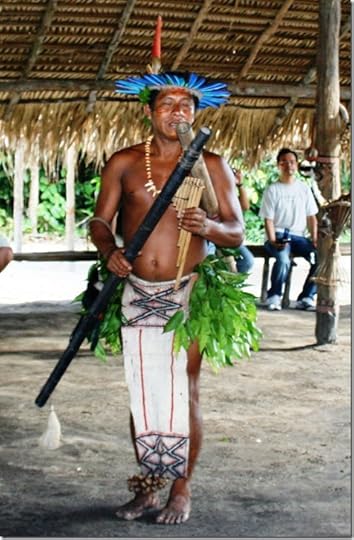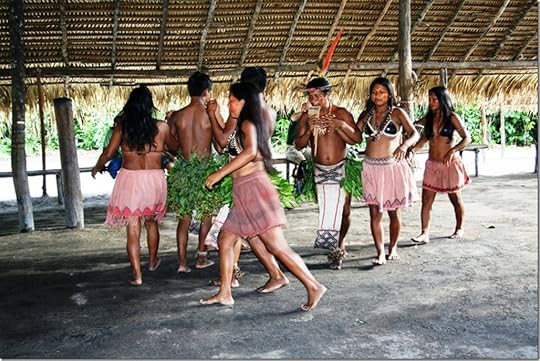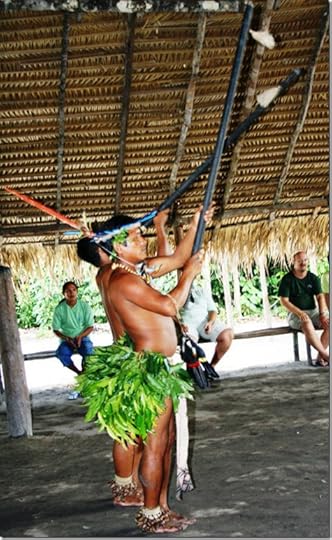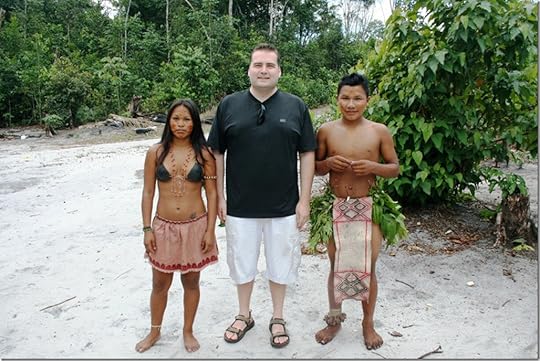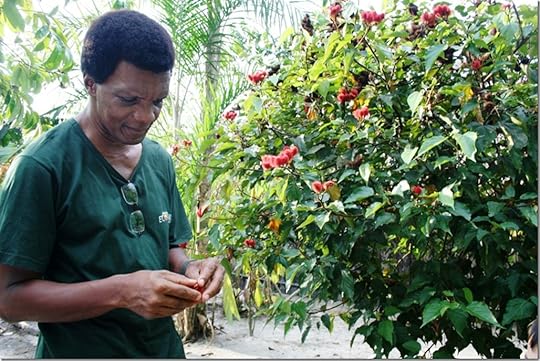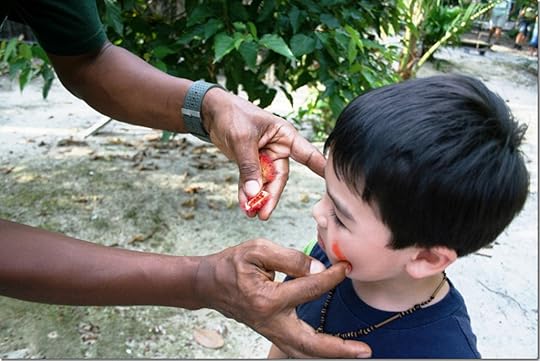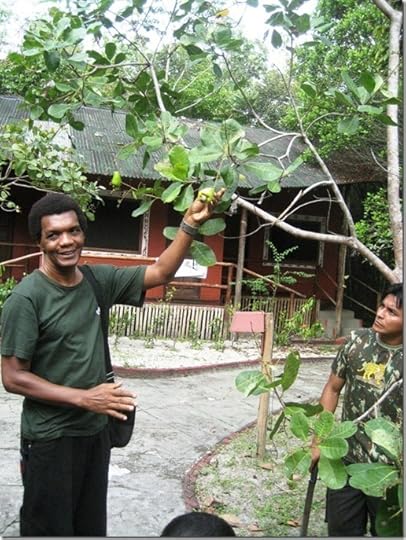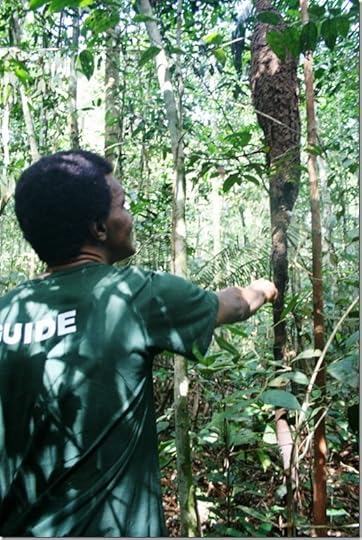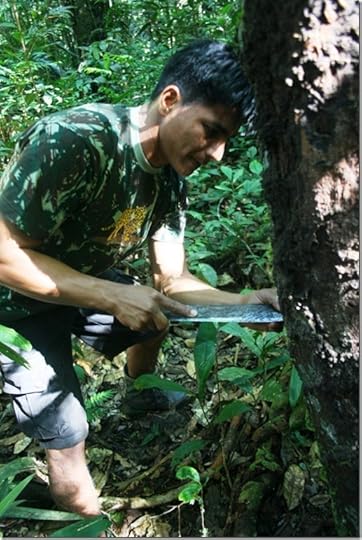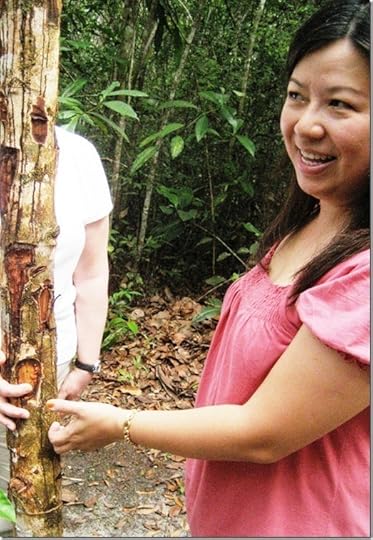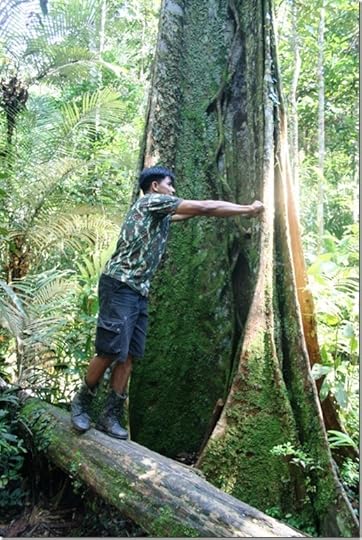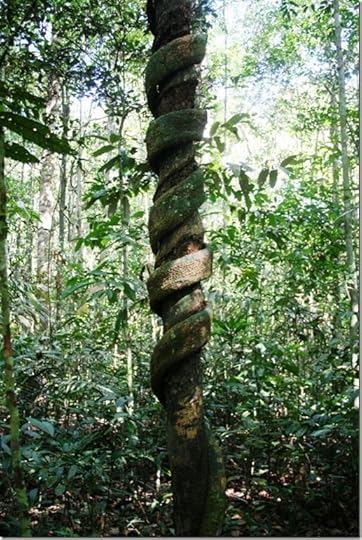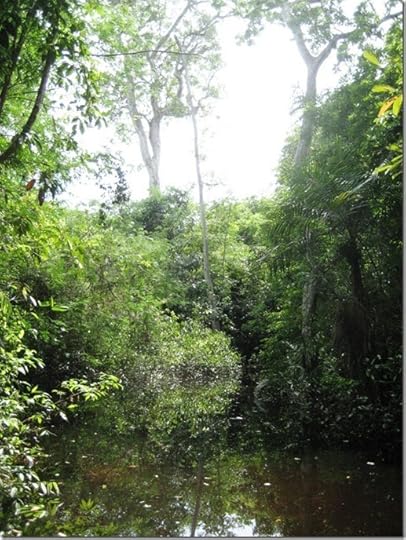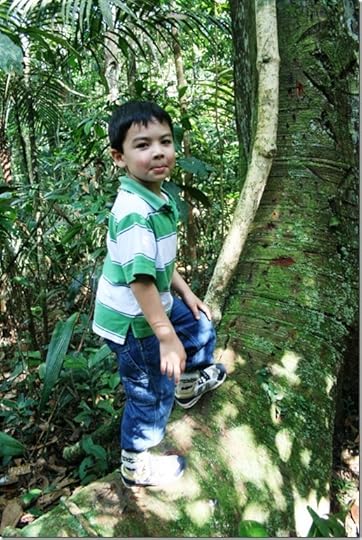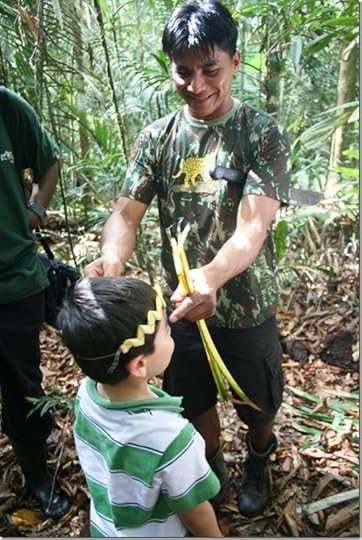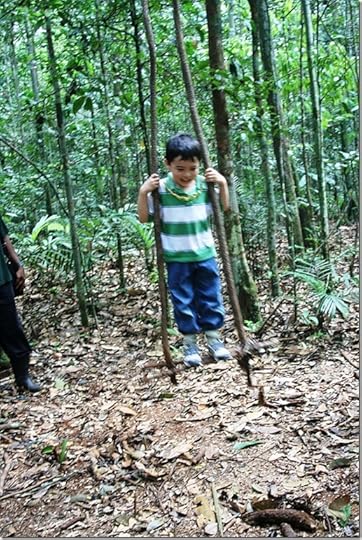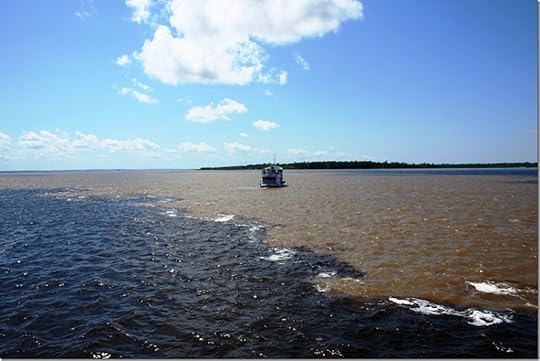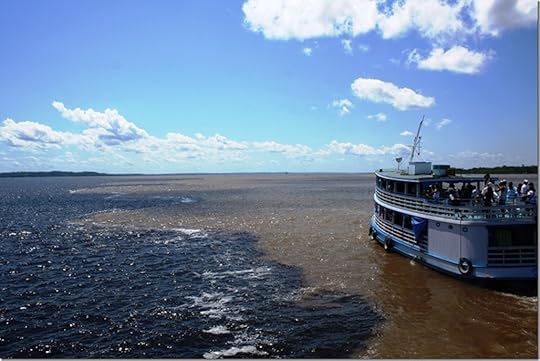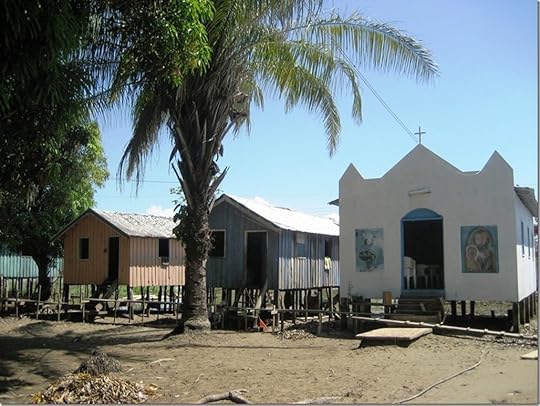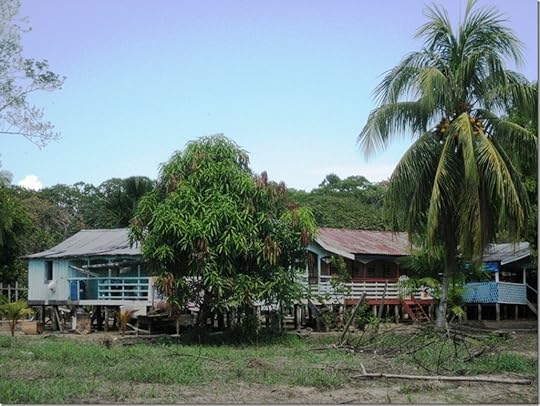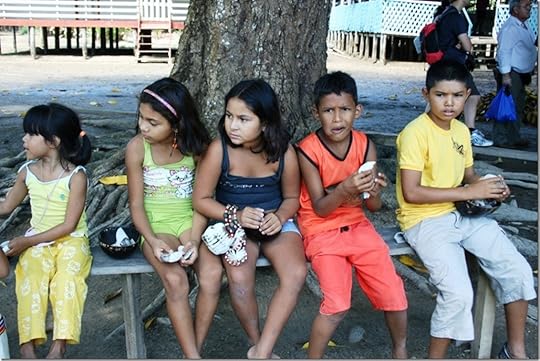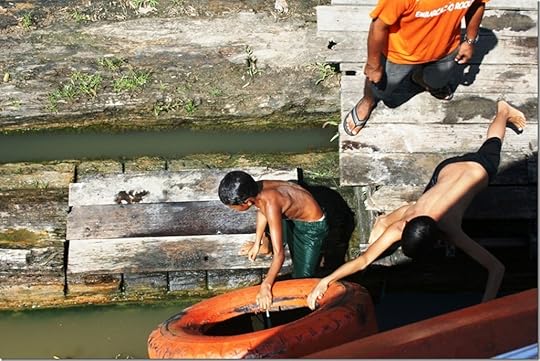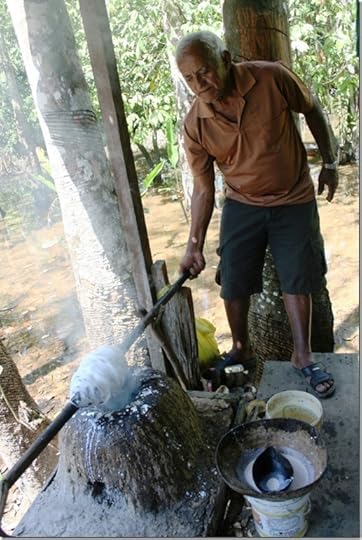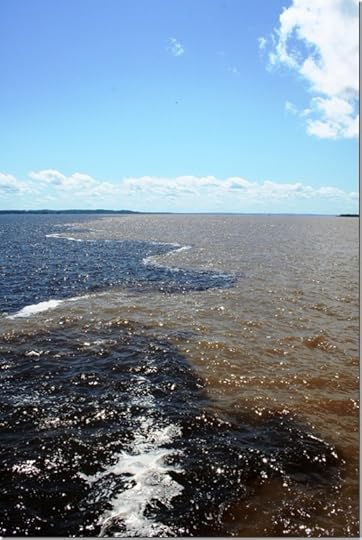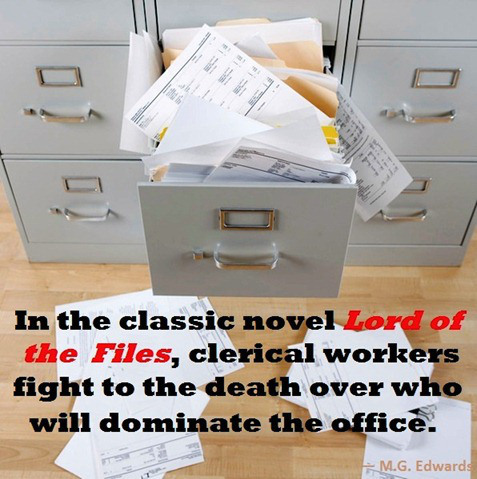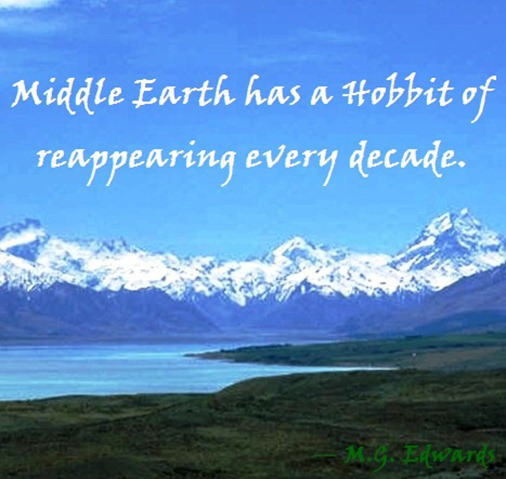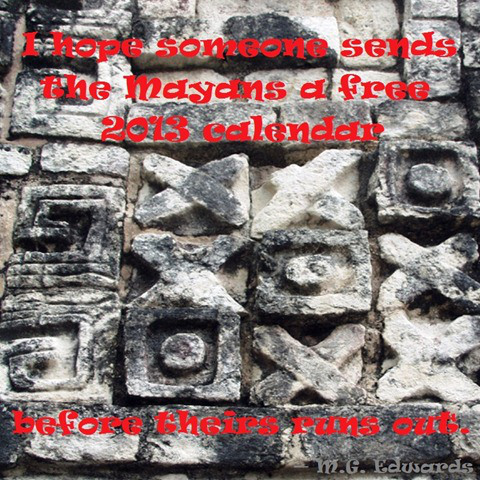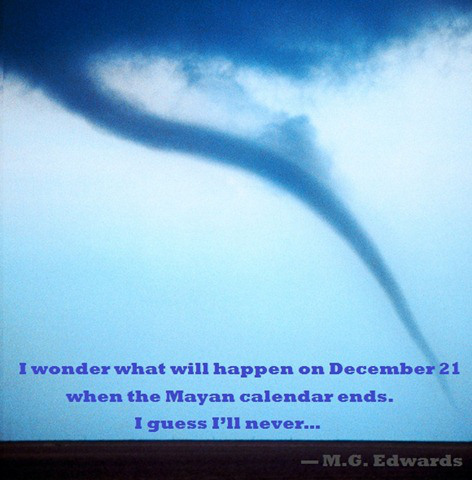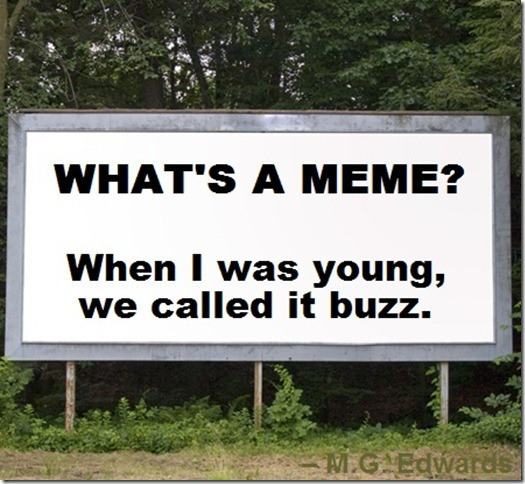M.G. Edwards's Blog, page 9
February 13, 2013
Eurasia: Austrian Express
This is the eighth installment of a story chronicling my travels in 1994 as a college student. The six-month journey took me to 19 countries in Europe and Asia.
Wednesday, March 2, 1994
I stood freezing on the platform at the Rosenheim train station awaiting the train to Austria and chilling under the bright morning sun too cold to warm the air. My frozen breath swirled thick over the tracks at the platform’s edge. Bystanders waiting nearby chatted with hearty laughs.
“How can they be so cheerful at a time like this?” I grumbled to no one. Shivering, I let out a faint cheer when the diesel train with a handful of passenger cars chugged into the station and screeched to a halt in front of me. It waited long enough for me to toss my life on board before taking off again. Pausing in the sheltered breezeway, I cupped and blew on my gloveless hands to warm them. The frosty air trapped inside my jacket and pants rebuffed attempts to unthaw.
In a passenger car filled with commuters, I found one seat next to a friendly, sixty-something German woman named Gertrude. She seemed excited to serve as my impromptu tour guide while the train chugged through the Bavarian countryside. A native to the area, she gave names in English to the scenic towns and villages, forests, meadows, and lakes that passed by. I marveled at how beautiful and orderly the southern German landscape was. Every town was like a Potemkin village and every farm a tourist showcase. Even the jagged, frosty mountains looked fashioned by hand. The grazing cows that shrugged off the cold weather seemed to have their own assigned places in the pastures; every forest tree planted by hand. Bavaria was like all the gorgeous rural scenes I’d ever seen rolled into one, from the grasslands of the Midwest to the foothills of the Rocky Mountains and the soaring peaks of the Cascades, with picturesque Alpine villages thrown in for good measure. Daylight painted Bavaria in a broader, more colorful brush than its reputation for beer, sauerkraut, and Oktoberfest.
As Gertrude described her home, she piqued my curiosity about what life there must have been like in days past. Peaceful and pristine, Bavaria was once wracked by the tumult of two World Wars, instability, Nazism, division, and a Cold War. Fresh from reunification, Germany had only recently undertaken its most recent post-war transfiguration. For a moment I wished that I could have glimpsed the past through her eyes. She kept talking about the beauty of her country, unaware that my mind was contemplating the past as much as listening to her present.
Gertrude said farewell at her home village not far from the Austrian border. I smiled and bid her Tschüß. Once again, the luggage resting above my head was my sole company.
In the early afternoon, Austria appeared in the window as the German train ended its journey at the border. Reluctantly vacating the warm compartment for the brisk winter air, my belongings weighing me down, I felt like a penguin waddling on a frozen beach on the way to Immigration and Customs. A policeman and two plainclothes officers stopped me in front of the Salzburg train station and demanded to see my passport. Handing it over, the thought crossed my worried mind that they had singled me out for special scrutiny because I looked like a vagabond. The fear that they would strip search me or rifle through my bags nagged me. I stood stoically, silent, as they examined my travel documents. They handed them back a moment later and waved me on without a word. Out of earshot and across the border in Austria, my exhaled sigh of relief billowed like a cloud.
I barely made it on the train to Bischofshofen before it started moving. Winded and feeling fatigued, I sank into a seat and glanced out the window at my adopted homeland. The quaint city of Salzburg filled with baroque architecture evoked images of Mozart and The Sound of Music. Then it disappeared like every other beautiful place I had seen. Feeling a bit despondent, I lamented that the trip was so rushed it left no time to enjoy what could have been a spectacular visit.
As the train crawled eastbound through the valley away from the Alps, the rugged landscape crumbled and gave way to decaying terrain recovering from dormant strip mines and unsightly factories strewn between the towns of Leoben and Brück an der Mur. The grayish Mur River followed the train like a shadow. Uniform pine trees marched by like a dispassionate military parade.
The village of Bischofshofen was little more than a quick stopover to catch the train from Vienna to Graz. As I sat alone with my thoughts at the deserted rail platform, loneliness and longing for my fiancée weighed on my mind. The realization that she wouldn’t be waiting dawned on me as my final stop drew near. We wouldn’t see each other again for six long months until our reunion on the other side of the world in Shanghai, China. No one, friends or family, would be there when I arrived in the city of Graz. Nothing would be the same for the next six months. This unfamiliar world promised to be new and different, yet the newness would undoubtedly grow old.
Time crept to a near standstill in the late afternoon as the train I caught in Bischofshofen approached Graz. It coasted casually into the Hauptbahnhof train station as if it didn’t have a care in the world. The city spread out and fell away from the train window into a valley where the old town clustered below a tall hill adorned with a clock tower. The view seemed to shimmer in a postcard panorama lit up by the sun peeking through the clouds. Seeing my adopted home for the first time triggered the same emotions — anticipation, weariness, impatience, curiosity, and frustration — that I felt when I touched down in Europe.
Suddenly, the city disappeared behind a grassy knoll. The train slid into the station and ground to a clanging halt, an unceremonious end to my journey. Home at last, I thought.
Previous installments of Eurasia:
3. Adventures in Frankfurt (Part One)
4. Adventurers in Frankfurt (Part Two)
Images of Bavaria courtesy of Microsoft. Photo of Graz property of M.G. Edwards.

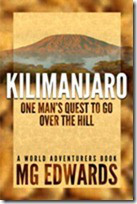 M.G. Edwards is a writer of books and stories in the mystery, thriller and science fiction-fantasy genres. He also writes travel adventures. He is author of Kilimanjaro: One Man’s Quest to Go Over the Hill, a non-fiction account of his attempt to summit Mount Kilimanjaro, Africa’s highest mountain and a collection of short stories called Real Dreams: Thirty Years of Short Stories. His books are available as an e-book and in print on Amazon.com and other booksellers. He lives in Bangkok, Thailand with his wife Jing and son Alex.
M.G. Edwards is a writer of books and stories in the mystery, thriller and science fiction-fantasy genres. He also writes travel adventures. He is author of Kilimanjaro: One Man’s Quest to Go Over the Hill, a non-fiction account of his attempt to summit Mount Kilimanjaro, Africa’s highest mountain and a collection of short stories called Real Dreams: Thirty Years of Short Stories. His books are available as an e-book and in print on Amazon.com and other booksellers. He lives in Bangkok, Thailand with his wife Jing and son Alex.
For more books or stories by M.G. Edwards, visit his web site at www.mgedwards.com or his blog, World Adventurers . Contact him at me@mgedwards.com , on Facebook , on Google+, or @m_g_edwards on Twitter.
For more books or stories by M.G. Edwards, visit his web site at www.mgedwards.com or his blog, World Adventurers . Contact him at me@mgedwards.com , on Facebook , on Google+, or @m_g_edwards on Twitter.
© 2013 Brilliance Press. All rights reserved. No part of this work may be reproduced or transmitted without the written consent of the author.


February 7, 2013
Eurasia: Rosenheim, Germany
This is the seventh installment of a story chronicling my travels in 1994 as a college student. The six-month journey took me to 19 countries in Europe and Asia.
I stepped onto the deserted platform at the Rosenheim train station at almost midnight, the only soul in sight. Silence greeted me until the train roared back to life and disappeared into the night bound for Austria. The bright lights on the platform cast a long shadow over my silhouette. An unexpected feeling of loneliness hit me even though I had been traveling solo for days and miles. For the first time, I was truly alone.
My friend Brigitte had promised weeks ago to meet me at the train station in Rosenheim, Germany, a small town 60 kilometers outside of Munich, on vague assurances that the midnight train would arrive on time. It passed through town like clockwork, but in spite of Germans’ penchant for precision, I second-guessed whether our timing or communication was messed up. Across the tracks was a small, brightly lit building with nary a soul. Maybe she was waiting there.
I hoisted my duffel bag on my shoulder, now wrought with painful sores, and dragged my luggage along the platform and into the pedestrian tunnel under the tracks. Emerging inside the station, I looked anxiously around for anyone who resembled Brigitte. My heart raced faster as my eyes scanned the open building but saw no sign of her.
A cold breeze blew through the porous building. On a freezing February night, the frosty air nipping at my body warmed by a heavy jacket and the friction created by unwieldy baggage, I dreaded to think what would happen if she didn’t appear. Perhaps I could have found a cheap youth hostel or waited in the train station until the attendants kicked me out. Freezing outside on a cold winter night was out of the question.
I left the station to look for her and noticed two women waiting outside near the main entrance. One looked like an older version of the six-year-old photo of Brigitte in my wallet. Waddling toward them, I asked, “Brigitte?”
She answered with a warm “Ja!” What a relief! After a long trip half way around the world from America to Germany, I was more than ready to rest. We hugged and greeted each other in a mixture of English and German. Brigitte introduced her mother, who ushered me into her small red Renault hatchback. Somehow, my luggage found room inside the tiny trunk. My not-so-svelte frame wiggled its way into the back seat of their car; tight but a sight better than braving the cold in search of cheap lodging.
As her mom drove slowly on icy roads through the quiet city, Brigitte asked me about my trip and initial impressions of Europe. Her wide eyes listened silently in the darkness as I recounted the journey and adventures along the way in Germany. An occasional chuckle escaped her lips. Curiosity nudged me to steal glimpses of Rosenheim. Its orange lights twinkling like little fires offered limited visibility in the darkness. The car’s dim headlights cast black shadows on the road.
We pulled into the driveway of a house not far from the train station. The dim exterior of the split-level home painted in ghostly hues by the porch light was eerily similar to that of an average American home. I trundled out, pulled one suitcase from the car trunk for my overnight stay, and followed Brigitte up the slick driveway to the front door. The interior of her home was rustic with a detached foyer, polished stone floors, and wood-paneled floors reminiscent of a Bavarian hunting lodge.
“This is cool,” I murmured as my eyes wandered around the house. I fought the urge to explore its corridors and look for secret passageways, coats of arms, and cuckoo clocks.
“Hast du Hunger?” Brigitte’s mom ushered me into the dining room and asked as if she had heard my stomach grumble.
“Ja, ich…ich habe Hunger,” I stumbled in German. She smiled with a look that said thanks for trying. Brigitte sat on the opposite side of a stout wooden dining table that looked like it had been hewn from a single pine tree. Her mom reappeared moments later with plates of wheat and rye bread, ham and würst cold cuts, four types of cheese, and mineral water. It was a better meal than any I could have asked for at the midnight hour. After a day of airline meals and stale junk food, it was simply divine.
Clad in a bathrobe, Brigitte’s father walked into the dining room and joined us for a chat. We talked in English about life in America and Germany while my taste buds savored the würst. Hearing their stories of idyllic Bavarian life left me regretting I couldn’t stay longer to enjoy the nearby mountains, forests, lakes, and castles. An album of photos from home added color to my stories about life in America.
The conversation crept into politics. With Germany five years removed from reunification in 1994 and heading into one of its first elections as a united country, the family seemed eager to talk about how far they had come since the end of the Cold War. I vowed not to embroil myself in tricky political discussions as a house guest but gave into the urge to debate, a leisure sport popular in Europe.
Exhausted, we retired in the wee hours of the morning. Brigitte’s mom put me in a room with her 18-year-old sister Lisa, who slumbered peacefully. I slept in a different bed but felt awkward spending the night with an unconscious stranger I’d never met. Not wanting to fill the room with the less-than-pleasant odor clinging to my well-traveled body, I took a shower in the adjacent room and savored my first bath in ages. The mirror reminded me of the stubble on my face, but my shaver rendered useless by an incompatible plug, I let it grow until I reached Austria.
My mind wandered as my body sank into bed. Thoughts of places seen and people met — Francisco, Thomas, Koji, Brigitte, and others — drifted through my fading conscious like spirits in the wind. I had finally met a longtime pen pal for the first time. Brigitte was nice but quiet; I wondered if she enjoyed our brief visit or what she thought of me. Perhaps seeing for the first time the boy she only knew through pen, paper, and a single photo was surreal to her too. Our friendship flourished in the days before the Internet made communications instantaneous, when a message’s transmission speed depended on whether it traveled by ship or par avion.
I woke a few hours later feeling refreshed. Searching for my watch, I noticed the time “8:30 a.m.” reflect in my eyes. It was only a few hours before the midmorning train bound for Austria passed through Rosenheim. A soft light peeked through the window curtains. My fingers gently peeled apart the shades for an incredible view of the German Alps just beyond Brigitte’s back yard. The postcard-perfect scene of the jagged, snowy mountains and lush pine forests begged for a castle or ski resort. It would have been an ideal image for a jigsaw puzzle.
I clenched my teeth knowing that I would soon leave this idyllic place and felt the urge to move in with Brigitte’s family. Looking around with a sheepish grin, I noticed that Lisa was already gone. She’d woken up to find an unconscious stranger she’d never met sleeping in her room. How ironic.
Rolling out of bed, I wandered to the dining room where Brigitte’s mom served a scrumptious Bavarian breakfast of toast, cheese and meat, bread with peanut butter and chocolate-hazel nut Nutella spread), and orange juice. What a life, I thought as I sat down next to my friend, who finished eating before leaving for work. Her father had already left with Lisa. As Brigitte stood, she smiled and said, “I wish you could stay with us longer.”
“I do too,” I replied. “Sorry the visit is so short. I hope we will meet again soon.”
We said a fond farewell, and then she was gone. I wished then that I had the foresight to give my friend something to remember the brief time we shared together.
Brigitte’s mom drove me to the train station after breakfast. Well rested, I enjoyed the return trip. Rosenheim looked beautifully Bavarian in the morning sunlight. The majestic, snow-covered Alpine mountains soaring above the town were breathtaking.
She helped me pile my luggage on the curb and bid me a fond farewell. I gave her a hug for good measure I hoped wasn’t too forward and waved enthusiastically as her red Renault drove away. I was the first American to stay with Brigitte’s family. I hoped the visit was a good one for them too.
Previous installments of Eurasia:
3. Adventures in Frankfurt (Part One)
4. Adventurers in Frankfurt (Part Two)
Images courtesy of Microsoft.

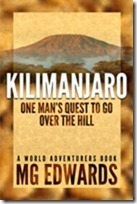 M.G. Edwards is a writer of books and stories in the mystery, thriller and science fiction-fantasy genres. He also writes travel adventures. He is author of Kilimanjaro: One Man’s Quest to Go Over the Hill, a non-fiction account of his attempt to summit Mount Kilimanjaro, Africa’s highest mountain and a collection of short stories called Real Dreams: Thirty Years of Short Stories. His books are available as an e-book and in print on Amazon.com and other booksellers. He lives in Bangkok, Thailand with his wife Jing and son Alex.
M.G. Edwards is a writer of books and stories in the mystery, thriller and science fiction-fantasy genres. He also writes travel adventures. He is author of Kilimanjaro: One Man’s Quest to Go Over the Hill, a non-fiction account of his attempt to summit Mount Kilimanjaro, Africa’s highest mountain and a collection of short stories called Real Dreams: Thirty Years of Short Stories. His books are available as an e-book and in print on Amazon.com and other booksellers. He lives in Bangkok, Thailand with his wife Jing and son Alex.
For more books or stories by M.G. Edwards, visit his web site at www.mgedwards.com or his blog, World Adventurers . Contact him at me@mgedwards.com , on Facebook , on Google+, or @m_g_edwards on Twitter.
For more books or stories by M.G. Edwards, visit his web site at www.mgedwards.com or his blog, World Adventurers . Contact him at me@mgedwards.com , on Facebook , on Google+, or @m_g_edwards on Twitter.
© 2013 Brilliance Press. All rights reserved. No part of this work may be reproduced or transmitted without the written consent of the author.


February 3, 2013
Thoughts & Sayings (February 2013)
Here are some thoughts and sayings I posted on Twitter and/or Facebook in January. To my knowledge, I made these up (for better or for worse). Sit back, relax, and enjoy the write!
Encouraging Words
1. Once you go off the beaten track, you never go back.
2. I’m like a shoe looking for its soul.
3. I feel de spare whenever I see my belly in the mirror.
Twisted Words
4. I can’t seem to keep that fly off the handle!
5. I didn’t want to shovel snow, so I glared at it until it melted.
6. Chickens recoop their losses when farmers take their eggs.
In Its Own Write
7. I’m going back to my cave to write and bang out something.
Holidays & Events
8. American adoptive parents left out in the cold by Russia, take heart! Thousands of wealthy Frenchmen are eagerly waiting to be adopted.
9. This year’s hot French travel destination is Russia.
10. I have a hunch 2013 will be unlucky, so I skipped a year.
11. How come 2013 doesn’t look much different than last year? I thought everything would change.
Random Musings
12.  is the Chinese character for LOL.
is the Chinese character for LOL.
13. Would yesterday’s masters succeed as contemporary artists?
14. If you’re selling Twitter followers, wouldn’t it be easier to make money selling 1 for a dollar?
15. This is the most important message you’re going to read. Until the next one.
Click here to visit the Thoughts & Sayings page, or click here to read the previous batch of Thoughts & Sayings.
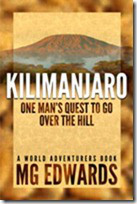 M.G. Edwards is a writer of books and stories in the mystery, thriller and science fiction-fantasy genres. He also writes travel adventures. He is author of Kilimanjaro: One Man’s Quest to Go Over the Hill, a non-fiction account of his attempt to summit Mount Kilimanjaro, Africa’s highest mountain and a collection of short stories called Real Dreams: Thirty Years of Short Stories. His books are available as an e-book and in print on Amazon.com and other booksellers. He lives in Bangkok, Thailand with his wife Jing and son Alex.
M.G. Edwards is a writer of books and stories in the mystery, thriller and science fiction-fantasy genres. He also writes travel adventures. He is author of Kilimanjaro: One Man’s Quest to Go Over the Hill, a non-fiction account of his attempt to summit Mount Kilimanjaro, Africa’s highest mountain and a collection of short stories called Real Dreams: Thirty Years of Short Stories. His books are available as an e-book and in print on Amazon.com and other booksellers. He lives in Bangkok, Thailand with his wife Jing and son Alex.
For more books or stories by M.G. Edwards, visit his web site at www.mgedwards.com or his blog, World Adventurers . Contact him at me@mgedwards.com , on Facebook , on Google+, or @m_g_edwards on Twitter.
For more books or stories by M.G. Edwards, visit his web site at www.mgedwards.com or his blog, World Adventurers . Contact him at me@mgedwards.com , on Facebook , on Google+, or @m_g_edwards on Twitter.
© 2013 Brilliance Press. All rights reserved. No part of this work may be reproduced or transmitted without the written consent of the author.


January 30, 2013
The Amazon Indigenous
This is the final article in a series about the Amazon region of Brazil featured in my illustrated picture book, Alexander the Salamander. This post is about the indigenous peoples and culture of the Amazon. Previous ones highlighted the Amazon River, the Meeting of the Waters, the rainforest, the city of Manaus, Amazon Ecopark, piranhas, and a monkey reserve. Enjoy these travelogues with photos and stories from one of the world’s mightiest rivers.
During our trip to the Amazon in July 2008, we took a daytrip to a small indigenous village near the Rio Negro. Built to attract tourists, the village was quite idyllic, and its inhabitants performed dances and sold handicrafts to visitors who wanted to experience local indigenous culture.
Our guide told me that the villagers belonged to the Baniwa indigenous group who had migrated from their original home upriver to this place in order to earn a better livelihood. Other members of the tribal group still living near the Brazil-Colombian border received financial support from them. According to Brazil’s Instituto Socioambiental, an estimated 15,200 Baniwa reside in the tri-border area of Brazil, Colombia, and Venezuela. Many reportedly live in poor conditions and are subjected to human rights abuses such as encroachment on their land by illegal loggers and poachers.
We disembarked from our tour boat and walked among wood and thatched-roof buildings to a large hall. We sat down on benches lining the hall and waited for the Baniwa performance to begin. Ten youths, five women and five men, performed songs and dance in ceremonial dress. The men played upbeat melodies on large wood flutes and pipes and chanted skyward as the women danced with them. Nothing represented the spirit of harmony between the indigenous and the rainforest to me more than their haunting songs that still echo in my mind.
As the dance grew livelier and less somber, the men pulled spectators from the audience and invited them to perform. My wife joined in. She tried to play the flute but was too preoccupied trying to dance! I opted out but took a photo afterwards with some of the performers. The lead performer made my son an honorary Baniwa, adorning him with a headdress and ceremonial stick.
After the performance, we were ushered to the souvenir shop, where my son tested a dart gun and we browsed the handmade art. We made sure that we were allowed to buy and export the souvenirs we bought.
Our son really enjoyed the visit, especially when our guide painted his face with berry juice. I’m glad he had the chance to experience a unique culture he might never have if we hadn’t visited the Amazon.
About Indigenous Peoples
Some international organizations and human rights groups have questioned the humanity of tourist attractions involving the indigenous and suggested that they are exploitative. As someone who has worked with the indigenous and documented indigenous issues, I support efforts to promote indigenous rights and applaud the efforts of governments, human rights organizations, and indigenous groups to improve their living conditions. I also favor allowing indigenous groups to support themselves legally as they wish. If they freely, without exploitation or prejudice by outside influence, determine that it is in their best interest to develop tourist attractions that showcase their cultures, they should be legally permitted to do so. It not only brings in much-needed revenue but promotes greater understanding of and preservation of indigenous cultures.
Click here to read about the Kayan-Lahwi (Karen or “Long-Neck” people) of Thailand and Burma
Click here to read about the Akha of Thailand and Burma
Click here to read about the Guaraní and Exnet of Paraguay
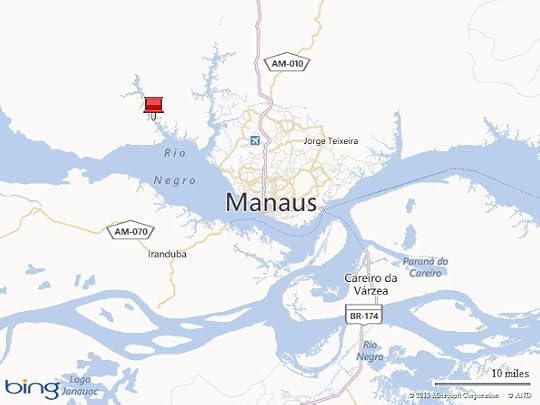
More About the Amazon
Click here to read about Manaus, Brazil.
Click here to read about piranhas, a well-known fish native to the Amazon.
Click here to read about the Amazon River.
Click here to read about the Amazon EcoPark Jungle Lodge.
Click here to read about an Amazon monkey reserve.
Click here to read about the Meeting of the Waters in the Amazon.
Click here to read about the Amazon rainforest.
About Alexander the Salamander
 A young salamander named Alexander living in the Amazon River Basin joins his friends Airey the Butterfly and Terry the Tarantula for an unforgettable jungle adventure. Come along with Alexander and friends as they meet birds, monkeys, and other creatures, enjoy the beauty of the rainforest, and face danger along the way.
A young salamander named Alexander living in the Amazon River Basin joins his friends Airey the Butterfly and Terry the Tarantula for an unforgettable jungle adventure. Come along with Alexander and friends as they meet birds, monkeys, and other creatures, enjoy the beauty of the rainforest, and face danger along the way.
The first book in the World Adventurers for Kids Series, Alexander the Salamander is an illustrated story inspired by the authors’ visit to the Amazon in 2008. Fun for kids and adults alike, the story teaches children the importance of listening to teachers and other authority figures.
M.G. Edwards is a writer of books and stories in the mystery, thriller and science fiction-fantasy genres. He also writes travel adventures. He is author of Kilimanjaro: One Man’s Quest to Go Over the Hill, a non-fiction account of his attempt to summit Mount Kilimanjaro, Africa’s highest mountain, a collection of short stories called Real Dreams: Thirty Years of Short Stories and Alexander the Salamander, a children’s story set in the Amazon. His books are available to purchase as an e- book and in print from Amazon.com and other booksellers. He lives in Bangkok, Thailand with his wife Jing and son Alex.
For more books or stories by M.G. Edwards, visit his web site at www.mgedwards.com or his blog, World Adventurers . Contact him at me@mgedwards.com , on Facebook , on Google+, or @m_g_edwards on Twitter.
© 2013 Brilliance Press. All rights reserved. No part of this work may be reproduced or transmitted without the written consent of the author.


January 27, 2013
Eurasia: A Respite to Rosenheim
This is the sixth of many installments chronicling my travels in 1994 as a college student. The six-month journey took me to 19 countries in Europe, the Russian Federation, and the People’s Republic of China.
I woke up from a fitful slumber unsure of my location until I remembered that I was on a train somewhere in Bavaria far from anyone or anyplace I knew. I didn’t even know where I was in Germany! The night kept me from getting a good look at the countryside as the high-speed train sped toward Munich like a bullet on silver tracks that cut through the darkness like a knife. The occasional lamp post flickered by, reminding me of a firefly leaving behind a wobbly trail. The luggage stowed overhead groaned as the train’s wheels bounced on the rails. For the time being, this was my world.
The train arrived in Munich about 9 p.m. My only view of the city was a broad boulevard as wide as a runway that stretched away from the train station. It was lit up like Christmas by cars, street lights, and neon signs, the biggest of which was the oversized BMW medallion adorning the company’s headquarters. This was my sole memory of Munich at the time. I have to come back and check out this place someday, I thought, a promise I fulfilled years later.
I disembarked at Munich’s Hauptbahnhof train station to catch my connection to Rosenheim. Throwing my luggage and myself on the platform, I struggled to locate my departing gate from among the mess of local connections scattered across the byzantine reader board. Rosenheim was just one of several stops on a slower commuter route through Bavaria. My eyes wandered from the board to my ticket to the trains and back until an attendant pointed me in the right direction.
The same drill I learned in Frankfurt played out in Munich as my feet trudged to the gate to wait what seemed like an eternity for the Rosenheim train. The building’s interior reminded me of the German stations depicted in World War II films with its aging architecture that once had a pre-modern elegance but had grown blighted by cracked pavement, sooty fixtures, and smoky air spewing from older trains. Time moved ever slower as I waited to leave, anxious to move on.
I dragged my life onto the train, tossed it overhead, and settled into a wagon with few seats to spare. I sat down next to a young Japanese man named Koji who was headed to Vienna. His affable demeanor gave me a nice respite from the monotony of listening to the sounds of the rail, a common soundtrack in the days before the birth of portable MP3 players. Conversing in English and bits of Japanese, Koji told me of his frustration in exaggerated expressions of traveling by rail in Europe. I laughed at his mimes, flailing hands, and his gruff, smoke-laden chuckles that kept me entertained all the way to Rosenheim.
We were two weary travelers getting by in a strange land, but somehow we managed. Koji spoke little English or German, and my knowledge of the Japanese language was limited to “hello,” “goodbye,” “thank you,” car brands, and sushi dishes. At least I could speak the local language, albeit marginally.
When the train arrived at the Rosenheim Station, I waved goodbye to my new friend and disembarked. I never saw Koji again. I’m not sure how he fared but was certain he finally reached his destination.
Previous installments of Eurasia:
3. Adventures in Frankfurt (Part One)
4. Adventurers in Frankfurt (Part Two)
Images courtesy of Microsoft.
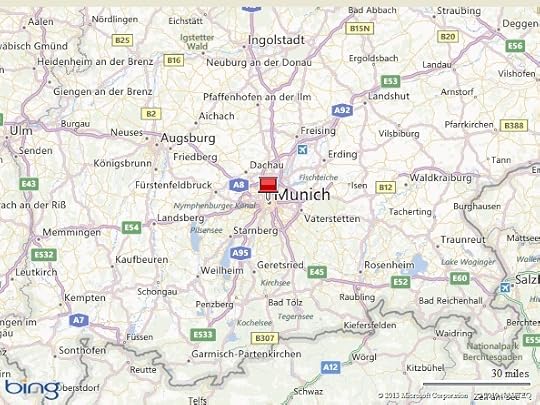
 M.G. Edwards
is a writer of books and stories in the mystery, thriller and science fiction-fantasy genres. He also writes travel adventures. He is author of Kilimanjaro: One Man’s Quest to Go Over the Hill, a non-fiction account of his attempt to summit Mount Kilimanjaro, Africa’s highest mountain,
a collection of short stories called
Real Dreams: Thirty Years of Short Stories
and Alexander the Salamander, a children’s story set in the Amazon. His books are
available to purchase as an e-
book and in print from
Amazon.com
and other booksellers. He lives in Bangkok, Thailand with his wife Jing and son Alex.
M.G. Edwards
is a writer of books and stories in the mystery, thriller and science fiction-fantasy genres. He also writes travel adventures. He is author of Kilimanjaro: One Man’s Quest to Go Over the Hill, a non-fiction account of his attempt to summit Mount Kilimanjaro, Africa’s highest mountain,
a collection of short stories called
Real Dreams: Thirty Years of Short Stories
and Alexander the Salamander, a children’s story set in the Amazon. His books are
available to purchase as an e-
book and in print from
Amazon.com
and other booksellers. He lives in Bangkok, Thailand with his wife Jing and son Alex.
For more books or stories by M.G. Edwards, visit his web site at www.mgedwards.com or his blog, World Adventurers . Contact him at me@mgedwards.com , on Facebook , on Google , or @m_g_edwards on Twitter.
© 2013 Brilliance Press. All rights reserved. No part of this work may be reproduced or transmitted without the written consent of the author.


January 23, 2013
Amazon Nature Walk
This is the seventh article in a series about the Amazon region of Brazil featured in my illustrated picture book, Alexander the Salamander. This post is about a nature walk in the Amazon. Previous ones highlighted the Amazon River, and the Meeting of the Waters, the city of Manaus, Amazon Ecopark, piranhas, and a monkey reserve. The next and final article will focus on the Amazon’s indigenous groups. Enjoy these travelogues with photos and stories from one of the world’s mightiest rivers.
During our visit to the Amazon region in July 2008, we took a long walk in the rainforest to explore under its canopy. The trained guides who led us through the jungle showed us a bevvy of interesting flora and fauna with so many useful properties that the walk was like exploring a natural laboratory. The promise and danger of this intriguing rainforest gave me a health respect for it. Our walk was a major inspiration for my children’s picture book, Alexander the Salamander, where Alexander and his friends get more than they bargained for when they wander too far into the Amazon rainforest.
As we walked, the guides demonstrated how some trees and plants produced a variety of compounds and substances that were poisonous, medicinal, flammable, or could be used or consumed by humans. Our guides showed us edible and poisonous fruit that looked startlingly similar to the untrained eye. They sampled sap from trees that could be used as a salve to treat wounds or as fuel for torches. One tree had bark that smelled like fragrant incense when burned. Another produced berries used in cosmetics. Years of exploration had uncovered many potential uses for the rainforest, convincing me that what we were seeing was just a glimpse of what this green realm offered.
My son was awestruck handling a fiery sap-fueled stick while my wife tried on bright orange nail polish made from small round berries.
Our guides showed us how a tree commonly known as the “telegraph” tree produced a loud echo that could be used to send coded messages over long distances. The forest’s acoustics easily beat any home theater system.
They also pointed out parasitic vines and foliage that grew from or wrapped themselves around trees in a delicate dance where both grew dependent on one another.
The guide pointed out some potential pitfalls, including plants with thorns sharper than needles and plants with poisonous or hallucinogenic properties capable of killing humans. We skirted a dark swamp hiding all sorts of nasties waiting for an unlucky trespasser. I was glad that we went with guides who knew how to avoid the Amazon’s pitfalls.
The guides made the walk more fun by showing us how plants and trees could be used for leisure. My son, who fancied himself the king of this jungle, loved the crown and glasses one of the guides fashioned from palm fronds.
My son and I both enjoyed swinging on a makeshift swing made from vines and sticks. The living vines were so strong that they easily bore my weight as I swung through the jungle like Tarzan!
Our tour of the Amazon rainforest taught us a healthy respect for this place filled with wonders yet to be discovered and unseen dangers lurking in dark corners.

More About the Amazon
Click here to read about Manaus, Brazil.
Click here to read about piranhas, a well-known fish native to the Amazon.
Click here to read about the Amazon River.
Click here to read about the Amazon EcoPark Jungle Lodge.
Click here to read about an Amazon monkey reserve.
Click here to read about the Meeting of the Waters.
About Alexander the Salamander
![clip_image0023[2]](https://i.gr-assets.com/images/S/compressed.photo.goodreads.com/hostedimages/1380918210i/3244570.jpg) A young salamander named Alexander living in the Amazon River Basin joins his friends Airey the Butterfly and Terry the Tarantula for an unforgettable jungle adventure. Come along with Alexander and friends as they meet birds, monkeys, and other creatures, enjoy the beauty of the rainforest, and face danger along the way.
A young salamander named Alexander living in the Amazon River Basin joins his friends Airey the Butterfly and Terry the Tarantula for an unforgettable jungle adventure. Come along with Alexander and friends as they meet birds, monkeys, and other creatures, enjoy the beauty of the rainforest, and face danger along the way.
The first book in the World Adventurers for Kids Series, Alexander the Salamander is an illustrated story inspired by the authors’ visit to the Amazon in 2008. Fun for kids and adults alike, the story teaches children the importance of listening to teachers and other authority figures.
M.G. Edwards is a writer of books and stories in the mystery, thriller and science fiction-fantasy genres. He also writes travel adventures. He is author of Kilimanjaro: One Man’s Quest to Go Over the Hill, a non-fiction account of his attempt to summit Mount Kilimanjaro, Africa’s highest mountain, a collection of short stories called Real Dreams: Thirty Years of Short Stories and Alexander the Salamander, a children’s story set in the Amazon. His books are available to purchase as an e- book and in print from Amazon.com and other booksellers. He lives in Bangkok, Thailand with his wife Jing and son Alex.
For more books or stories by M.G. Edwards, visit his web site at www.mgedwards.com or his blog, World Adventurers . Contact him at me@mgedwards.com , on Facebook , on Google+, or @m_g_edwards on Twitter.
© 2013 Brilliance Press. All rights reserved. No part of this work may be reproduced or transmitted without the written consent of the author.


January 20, 2013
Martin Luther King, Jr.–A Lifetime of Change
A reader, Allison Miller, read my previous pieces on Dr. Martin Luther King, Jr. and contacted me to share an infographic she developed to honor his legacy. It’s a wonderful visual timeline of some key moments in his life and how it changed the United States. This year, I want to honor Dr. King’s legacy by sharing with you her work and insights behind her project. I could not have said it better myself. She wrote:
After all the celebrations that come with the month of December, it’s easy to feel like the rest of winter is empty of special occasions or reasons to celebrate. One important day to commemorate, however, falls in the middle of January and is certainly a cause for thanks and remembrance: Martin Luther King Jr.’s birthday. People honor and celebrate the life of Dr. King for many reasons, but most importantly, for his role in working to achieve race equality in America. Dr. King had arguably the greatest impact of any single person during the fight for racial equality, and the fact that his life was cut short causes people to wonder what he may have gone on to achieve in his lifetime. History is full of important, memorable figures, but for those individuals who have helped influence equality, it’s especially important to honor their achievements. Most children learn a bit about Dr. King in schools today, but it’s vital to continue that conversation outside of the classroom and in the world, where equality issues are still pressing. The following infographic presents a timeline of the life of Martin Luther King Jr., to honor his legacy and fuel the conversation about his battle for equality.
Thank you, Allison, for sharing your work and reminding us of Dr. King’s legacy and the importance of racial equality not only in the United States but throughout the world.
Special thanks to Allison and OnlineCollegeCourses.com for sharing this infographic. Click here to visit their website. The work is protected under a Creative Commons license and can be reposted with attribution to OnlineCollegeCourses.com.
More About Dr. Martin Luther King, Jr. and the U.S. Civil Rights Movement
Martin Luther King, Jr. Day (2012)
Martin Luther King, Jr.’s Legacy (2006)
Reflecting on Dr. King (2005)
Thank You, Rosa Parks (2005)


January 16, 2013
Introducing Brilliance Reviews
Dear Reader, let me introduce you to Brilliance Reviews, my new blog dedicated to reviews of the books, novels, and short stories I’ve read. I will publish a new post whenever I finish reading and reviewing a work. You’re welcome to follow Brilliance Reviews as well as World Adventurers; both will run independently.
Why are you starting a new blog? Book reviews didn’t fit the theme of my current blog, World Adventurers, which has evolved into a popular blog featuring travelogues and whimsical musings about life. Both blogs have unique target audiences. World Adventurers will primarily feature my work while Brilliance Reviews will focus on other authors’ works.
What kind of books do you review? I’m an avid reader and enjoy discovering books from many genres. Book written by indie authors are of particular interest to me because I believe that much of the groundbreaking literature is being written by self-published authors. I still read traditionally published books and will review those too, but my preference is toward indie authors’ works.
What kinds of book reviews do you write? I try to write honest reviews with a 1-5 star rating (1 being poor and 5 being excellent), clearly stating whether I recommend the book (or not). I try to offer positive and negative points about each book regardless of their rating. No book is perfect, and most have at least some redeeming qualities that attract certain types of readers even if I don’t like them. The reviews reflect my own opinions, and I recognize that others may enjoy books I don’t.
How did you get started? For the past year, I made it a habit of posting book reviews on Amazon, Goodreads, and other sites. I thought it was time to post them on a single blog that others can follow. The purpose is to support fellow writers, especially indie authors, who need book reviews to get the word out about their books. I’m happy to support my peers whenever I can.
How often will you post reviews? I try to read about three books a month and post reviews. I’ll post as often as I can.
Why did you choose the name Brilliance Reviews? Brilliance Press is the name of my publisher. I chose the name because it evokes positive images of something intelligent or dazzling.
I’m an indie author. Will you review my work? If you’re an indie author and would like to submit an book for review, contact me at me@mgedwards.com and send me your book in Kindle (MOBI) format. I don’t accept print books. I can’t guarantee that I will review your book or give it a high rating. Reviews will be posted to Brilliance Reviews and the book’s page on Amazon and Goodreads. Those who submit their books for me to review must agree to allow the cover art to be published along with the review and accept the rating and review I give. I will try to give honest feedback.
Do you do author interviews? Certainly. I’m happy to feature other authors on this blog. If you want to be interviewed for this blog or cross-post material, contact me at me@mgedwards.com.
I hope you’ll follow Brilliance Reviews and learn more about some of the great books out there waiting to be discovered.
M.G. Edwards is a writer of books and stories in the mystery, thriller and science fiction-fantasy genres. He also writes travel adventures. He is author of Kilimanjaro: One Man’s Quest to Go Over the Hill, a non-fiction account of his attempt to summit Mount Kilimanjaro, Africa’s highest mountain, a collection of short stories called Real Dreams: Thirty Years of Short Stories and Alexander the Salamander, a children’s story set in the Amazon. His books are available to purchase as an e-book and in print from Amazon.com and other booksellers. He lives in Bangkok, Thailand with his wife Jing and son Alex.
For more books or stories by M.G. Edwards, visit his web site at www.mgedwards.com or his blog, World Adventurers . Contact him at me@mgedwards.com , on Facebook , on Google , or @m_g_edwards on Twitter.
© 2013 Brilliance Press. All rights reserved. No part of this work may be reproduced or transmitted without the written consent of the author.


January 13, 2013
Meeting of the Waters in the Amazon
This is the sixth article in a series about the Amazon region of Brazil featured in my illustrated picture book, Alexander the Salamander. This one is about the Meeting of the Waters. Previous travelogues highlighted the Amazon River, the city of Manaus, Amazon Ecopark, piranhas, and a monkey reserve. Upcoming articles will focus on the rainforest and indigenous peoples. Enjoy these travelogues with photos and stories from one of the world’s mightiest rivers.
The Meeting of the Waters, where two major tributaries, the Rio Negro and Rio Solimões, merge and form the Amazon River, is a sight to behold. Like the convergence of the Blue and White Nile rivers in Africa, the collision of these rivers is a spectacular mixture of color that looks like a blend of black coffee and milk tea. The darker Rio Negro with its decaying, organic debris and foliage flows into the light brown Rio Solimões. The result is a swirl of lighter and darker water that ebbs and flows for more than six miles downstream like yin and yang.
Differences in the temperature, speed, and water density create a boundary between the two rivers that continues like an impenetrable wall until the Rio Negro is finally absorbed by the Solimões. The slower-moving water of the Rio Negro flows about two kilometers per hour at a temperature of 28°C (82°F) while the Solimões moves up to six kilometers per hour at 22°C (72°F).
In July 2008, we took a river cruise from the Amazon Eco-Park Jungle Lodge to see this phenomenon. The swirling mixture of water looked almost potable. Almost. Our boat cruised for a while up and down the snaking line, giving us the chance to snap photos. I watched in amazement as the Gemini twins battled for supremacy. The Solimões was the more aggressive of the two. Sometimes it made some gains; sometimes the Negro rebuffed its advance.
Our cruise boat departed the Meeting of the Waters about noon and passed through shallow water of a channel on the Rio Solimões. I wondered whether the trees protruding from the water were tall or the boat was close to scraping the riverbed.
We stopped for lunch at a small village not far from the Meeting of the Waters. It was just half an hour downstream from the city of Manaus but felt a world away. With no motorized vehicles that I could tell, the residents relied on their feet and boats to get around. The church and school were the main buildings in the small, dry earthen square shaded by stately palms.
The locals seemed industrious and enterprising. They helped the tourists who disembarked to eat and browse the large gift shop filled with handmade souvenirs like stuffed and mounted piranhas that were presumably made by the villagers. I’m sure the residents earned a healthy income from the steady stream of tourists who visited each year. Others were busy working on the dock, farming, or fishing.
I saw one villager making rubber from the sap of a rubber tree. After tapping the tree with cuts that looked like slashes from a bear’s claws, the man collected the oozing white substance in a container and melted it into a large ball on a stick. I assumed that he was gathering the rubber to sell to a manufacturer or broker.
We returned to the Meeting of the Waters in the afternoon and followed the Rio Negro upstream past Manaus to our resort. Another day in the Amazon introduced us to yet more facets of this fascinating place.

More About the Amazon
Click here to read about Manaus, Brazil.
Click here to read about piranhas, a well-known fish native to the Amazon.
Click here to read about the Amazon River.
Click here to read about the Amazon EcoPark Jungle Lodge.
Click here to read about an Amazon monkey reserve.
About Alexander the Salamander
 A young salamander named Alexander living in the Amazon River Basin joins his friends Airey the Butterfly and Terry the Tarantula for an unforgettable jungle adventure. Come along with Alexander and friends as they meet birds, monkeys, and other creatures, enjoy the beauty of the rainforest, and face danger along the way.
A young salamander named Alexander living in the Amazon River Basin joins his friends Airey the Butterfly and Terry the Tarantula for an unforgettable jungle adventure. Come along with Alexander and friends as they meet birds, monkeys, and other creatures, enjoy the beauty of the rainforest, and face danger along the way.
The first book in the World Adventurers for Kids Series, Alexander the Salamander is an illustrated story inspired by the authors’ visit to the Amazon in 2008. Fun for kids and adults alike, the story teaches children the importance of listening to teachers and other authority figures.
M.G. Edwards is a writer of books and stories in the mystery, thriller and science fiction-fantasy genres. He also writes travel adventures. He is author of Kilimanjaro: One Man’s Quest to Go Over the Hill, a non-fiction account of his attempt to summit Mount Kilimanjaro, Africa’s highest mountain, a collection of short stories called Real Dreams: Thirty Years of Short Stories and Alexander the Salamander, a children’s story set in the Amazon. His books are available to purchase as an e- book and in print from Amazon.com and other booksellers. He lives in Bangkok, Thailand with his wife Jing and son Alex.
For more books or stories by M.G. Edwards, visit his web site at www.mgedwards.com or his blog, World Adventurers . Contact him at me@mgedwards.com , on Facebook , on Google+, or @m_g_edwards on Twitter.
© 2013 Brilliance Press. All rights reserved. No part of this work may be reproduced or transmitted without the written consent of the author.


January 6, 2013
Thoughts & Sayings (January 2013)
Here are some thoughts and sayings I posted on Twitter and/or Facebook in December. To my knowledge, I made these up (for better or for worse). Sit back, relax, and enjoy the write!
Encouraging Words
1. Humans need a charger so they can unplug and recharge their batteries.
Twisted Words
2. A predator preys before meals.
3. I didn’t want to mow the grass, so I told it to sod off.
4. I am chopped liver. I enjoy life in bits and pieces.
In Its Own Write
5. In the classic novel “Lord of the Files,” clerical workers fight to the death over who will dominate the office.
Holidays & Events
6. News Flash! The paparazzi went to the hospital with sympathy pains following news of the Duchess of Cambridge’s pregnancy.
7. Wishing you a happy 12-12-12, the last repetitive date in your lifetime. The last repetitive date in your lifetime. The last repetitive date in your lifetime.
8. Middle Earth has a Hobbit of reappearing every decade.
9. I hope someone sends the Mayans a free 2013 calendar before theirs runs out.
10. Some believe that a Mayan scribe ran out of ink on December 20.
11. December 20 is 20-12-2012. Something tells me that this means something.
12. It’s not the end of the world if nothing happens on December 21.
13. I wonder what will happen on December 21 when the Mayan calendar ends. I guess I’ll never…
14. This is a public announcement. The apocalypse has been postponed.
15. Last year my vision was 20-12. May your vision in 2013 be better than mine.
Random Musings
16. I am exhausted from dealing with Taylor Swift’s relationship issues and breakups.
17. I’m welcoming my in-laws with open arms and fingers crossed.
18. What’s a meme? When I was young, we called it buzz.
Click here to visit the Thoughts & Sayings page, or click here to read the previous batch of Thoughts & Sayings.
Images courtesy of Microsoft.
![buythumb[3]](https://i.gr-assets.com/images/S/compressed.photo.goodreads.com/hostedimages/1381230023i/4565645.jpg) M.G. Edwards is a writer of books and stories in the mystery, thriller and science fiction-fantasy genres. He also writes travel adventures. He is author of Kilimanjaro: One Man’s Quest to Go Over the Hill, a non-fiction account of his attempt to summit Mount Kilimanjaro, Africa’s highest mountain, a collection of short stories called Real Dreams: Thirty Years of Short Stories and Alexander the Salamander, a children’s story set in the Amazon. His books are available to purchase as an e-book and in print from Amazon.com and other booksellers. He lives in Bangkok, Thailand with his wife Jing and son Alex.
M.G. Edwards is a writer of books and stories in the mystery, thriller and science fiction-fantasy genres. He also writes travel adventures. He is author of Kilimanjaro: One Man’s Quest to Go Over the Hill, a non-fiction account of his attempt to summit Mount Kilimanjaro, Africa’s highest mountain, a collection of short stories called Real Dreams: Thirty Years of Short Stories and Alexander the Salamander, a children’s story set in the Amazon. His books are available to purchase as an e-book and in print from Amazon.com and other booksellers. He lives in Bangkok, Thailand with his wife Jing and son Alex.
For more books or stories by M.G. Edwards, visit his web site at www.mgedwards.com or his blog, World Adventurers . Contact him at me@mgedwards.com , on Facebook , on Google , or @m_g_edwards on Twitter.
© 2013 Brilliance Press. All rights reserved. No part of this work may be reproduced or transmitted without the written consent of the author.



